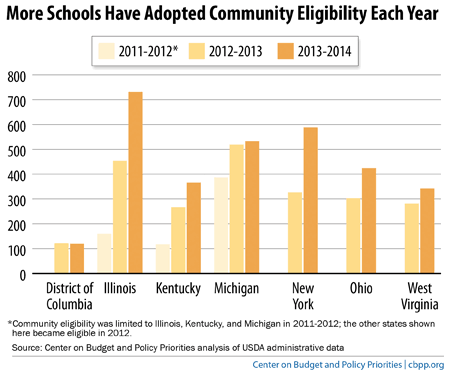off the charts
POLICY INSIGHT
BEYOND THE NUMBERS
BEYOND THE NUMBERS
Community Eligibility: A Proven Tool to Address Child Hunger
Receive the latest news and reports from the Center
Many school districts across the country are adopting community eligibility — which allows high-poverty schools to offer breakfast and lunch to all students at no charge without having to process meal applications — to support their students’ health and learning. Some eligible districts are wary of the new option (which hasn’t been available nationwide until now) and want to make sure any glitches are worked out before signing up. But newly available data from the seven states that have had the option for two or three years show that many school districts that took a “wait and see” approach liked what they saw and signed up the next year.
In six of those seven states, the number of schools offering community eligibility grew steadily each year (see chart). And in the seventh, the District of Columbia, more than half of all students attend community eligibility schools, though the number of participating schools dipped the second year as two schools closed for unrelated reasons.

So, districts considering community eligibility need not worry about being guinea pigs. Thousands of schools serving nearly 2 million students have already tested it.
Those states and school districts have also developed useful materials that districts considering the option can use. And the Agriculture and Education departments have answered many of the implementation questions they raised.
In short, community eligibility is a proven tool to help children receive the healthy meals they need to learn and thrive.